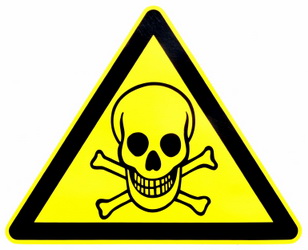Pretty much everyone is aware that many people are allergic to peanuts, and many schools even ban any form of peanuts because of the dangers to children who may be allergic. Any severe allergy to a food, or something else, can be life threatening. (It may actually be the molds/fungus or aflatoxin that people are allergic to rather than the peanuts.)
What a lot of people aren't aware of are the other dangers of peanuts. I don't eat peanuts, in any form, mostly because of that. Peanuts can be confusing because we hear they contain a good fat, monounsaturated, but so do avocados, nuts (which peanuts aren’t)and olive oil, which would be healthier choices. Peanuts also contain a high amount of omega-6, but a more balanced omega-6 to omega-3 ratio would be best as in hemp seeds, fish oil or a high grade natural supplement. We also hear peanuts are high in antioxidants and some vitamins and minerals. The biggest claim to health lately has been that they contain resveratrol, which they do, but so do other foods, such as grapes, cranberries and blueberries, so you don't need to eat peanuts for that benefit either.
One problem with peanuts is that they are one of the most highly pesticide contaminated crops there is. One important reason to only use organically grown peanut products if you choose to continue to eat peanuts. Conventional peanut farmers have a disproportionately high rate of cancer, mainly because of all the pesticides they use, and because they eat a lot of peanuts.
But the most important reason not to eat peanuts or peanut butter is because they are often contaminated with aflatoxin. Aflatoxin is a mycotoxin that is produced by many different species of a fungus called Aspergillus. It is very dangerous, and it is a carcinogen. It is so potent it has been known to wipe out complete tribes in Africa because of contaminated food there. In smaller amount it can be a slow killer, as in cancer, and is believed to cause liver cancer. (Aflatoxin can be in other products as well, corn is another likely one, which is another thing I don't eat.)
Peanuts are particularly susceptible to contamination during growth and storage. Poor storage of peanuts can lead to an infection by the mold fungus Aspergillus flavus, releasing the toxic and highly carcinogenic substance aflatoxin. The aflatoxin-producing molds exist throughout the peanut growing areas and may produce aflatoxin in peanuts when conditions are favorable to fungal growth.
Organic Peanut Butter is part of the top 5 items to buy organic. Why should you focus on peanut butter? This is because, many peanut farms contaminate their peanut crops with a chemical to treat mold. This mold is one of the major problems that causes peanut crops to die. This chemical is classified as a fungicide.

The peanut, or groundnut (Arachis hypogaea), is a species in the legume or "bean" family (Fabaceae).
The most common way most people get aflatoxin in their diets is through peanut butter. Peanuts have an especially high naturally-occurring concentration of aspergillus flavus mold. Furthermore, while most peanuts are roasted, the roasting process rarely kills all the mold. The longer peanuts sit around in the store or in your house, the more of the mold will grow back--and again, it generally won't be visible to the naked eye. The longer the mold grows, the more aflatoxin builds up.
Here's the most interesting thing about all this: usually your "organic" or "natural" peanut butters will have the highest aflatoxin concentration. The highest concentration of all, though, will typically be the stuff you buy in the store where they take peanuts and grind them into peanut butter for you while you wait. Because while the USDA and FDA has rules for how much aflatoxin is allowed in food before it's shipped to stores, there's no measure of it after it reaches the stores. Those peanuts could have been sitting on the shelves at the story for weeks or months at room temperature, building up mold. It's even worse if the air is mildly moist. Furthermore, if you fresh-grind those nuts into peanut butter, the mold keeps growing in the peanut butter.
This means that your safest source of peanut butter is generally your cheap, garden variety Jif or Skippy or the like (But Skippy just had a recall). The companies that make those generally get the peanuts fresh, roast and grind them immediately, put them through an effective cooking and homogenization process, then seal them in airtight jars. The mold buildup on those will be much lower than your typical "fresh" or "natural" peanut butters and they pretty quickly out of the stores.
The risks for children are the highest as their health can be even more impacted then adults because of their size and their still developing immune systems. And often they eat more of it regularly than adults. Pets can also have both allergies or negative affects from the molds, fungus and toxins.
Our suggestion… don’t eat peanuts, peanut butter or organic peanut butter… period!!
By the way, the aflatoxin threat is taken seriously enough that OSHA actually requires workers dealing with large quantities of peanuts to wear facial masks so they don't breath in too much of the mold. And statistically, just as a rule of thumb, two tablespoons of peanut butter a day (regular or organic) produce a higher risk of death than living next to a nuclear power plant.


The number one thing to look for in organic peanut butter is that it is made from organically ‘grown’ peanuts and that it is a brand bought at a store where the jars move quickly!
From the lists and surveys, these seem to be the top 6 Organic Peanut Butters:

1. Nature's Promise - This peanut butter is made of 100% natural ingredients. Also, Nature's Promise has been around for a while, and supplies many products. Such as, milk, butter, broth, snacks, pizza, and cookies.
2. SunLand Dark Chocolate Peanut Butter- SunLand has been around since 1988, and it is dedicated strictly peanut butter. Best of all, it is United States based; New Mexico to be exact. SunLand's peanut butter is very unique also; the company has many different flavors. The flavors range from "Regular" to "Hickory Smoke".
3. Santa Cruz Organic Peanut Butter - Their peanut butter comes in four flavors; Dark Roasted Creamy, Dark Roasted Crunchy, Light Roasted Creamy, Light Roasted Crunchy. Although, this brand does not only make peanut butter. They also make a variety of items from juices to chocolate syrup.
4. Adams - Adams has been around since 1922. There peanut butter is 100% all natural. They make natural, organic, and no stir peanut butter. While their natural peanut butter has four choices, their organic peanut butter has two choices of varieties.
5. Justin's Organic - This brand is awesome. They now make chocolate flavored peanut butter. Those flavors are "Chocolate Peanut Butter", "Chocolate Hazelnut Butter", and "Chocolate Almond Butter". My personal favorite is "Chocolate Hazelnut Butter", and "Chocolate Almond Butter".
6. Maranatha Nut Butters - This company has been around since 1982 in Ashland, Oregon. The company to use the purest ingredients, and now allows for their peanut butters to be brought online. I favor two of the products by Maranatha Nut Butter. Those products are Dark Chocolate Peanut Spread and Dark Chocolate Almond Spread. Both have a dark chocolate flavor, making them both irresistible.
Does anyone else long for the days when rat droppings were the scariest thing about peanut butter? Anyone? Show of hands?
Let's see. The problems with peanut butter now include:
- Really scary chemicals, including neurotoxins (as if we need something else getting on our nerves).
- Deadly salmonella outbreaks.
- The mysterious rise of very serious peanut allergies.
- A peanut butter aisle so big that it makes you want to curl into a ball and rock back and forth -- right there in the store -- from stimulation overload. (Omega-3 peanut butter ... really?)
- Rat feces, still.
- The Frankenut-butter threat. Although there are no genetically modified peanuts on the market right now, according to the National Peanut Board website, money is being poured into genomic research. (Note to peanut growers: Consider inserting the genes of a Labradoodle. As far as I can tell, no one is allergic to them.) But seriously, on the upside genetically modified peanuts could save lives.
OK, peanut allergies aside, some of the contemporary problems with peanut butter can be avoided by buying organic peanut butter. Of course, this begs some questions: Do any of these organic spreads taste good? And do you have to break the bank for a peanut-butter-and-jelly sandwich?
And while we're at it, is the "Skippy Factor" real? A while back, when I wrote about turkey, I spoke with Cooks Illustrated senior editor Lisa McManus. She described the Skippy Factor this way: Tasters often favor foods that are comfortingly familiar, such as Skippy peanut butter, over something higher quality. (This also explains why Cooks, which I read regularly, is so shockingly successful. For these food science geeks, taste trumps all. They don't really give a rip about health-consciousness or greenness or food trends.)
So, back to the point: Do organic peanut butters taste good? ARe they worth the extra money? And if they are… choose from the six organic creamy peanut butters that were readily available at local grocery stores that move off the shelves.
h/t to Lou Bendrick, Jeanne Coffey, Sanoviv, Dr. Mercola
One Way To Mitigate The Risks Of Aflatoxin
The best way to avoid any risks from peanuts is to avoid eating them. There is something you can do, though, if you still feel the need to consume peanuts and peanut butter, even with all the risks. One type of peanut has been fairly resistant to aflatoxin, and that is the Valencia peanut, which is grown mostly in New Mexico. These type of peanuts, when they are grown in the southwest of the US, mainly New Mexico, grow in dry conditions not conducive to aflatoxin, a mold which likes moisture.
One problem is that not all Valencia peanuts are grown in that area, but most are. If you use Arrowhead Mills organic peanut butter, you will avoid the pesticides and the aflatoxin, because it is made with organic Valencia peanuts, and that particular brand has never been shown to contain aflatoxin at all.
Although, that is no guarantees it will be that way forever, but it is certainly the safer way to go.
Choices:
-
Stop eating peanuts and peanut products
-
Eat regular peanut butter because is moves quicker and there is somewhat less chance of getting sick from the molds and fungus (aflatoxin)
-
Eat organic peanut butter because you won’t get the pesticides, but you might get more of the mold and fungus
-
Through care to the wind and take your chances…
So in the end we suggest… skip eating peanuts, peanut butter and organic peanut butter all together… period!! And definitely don’t feed feed them to your kids or pets!



![clip_image003[5] clip_image003[5]](https://blogger.googleusercontent.com/img/b/R29vZ2xl/AVvXsEg0r0SNrjjSnUuCktoPLCiUXXaQXtHsjRMEu6PPlXGbfSapZSaa9DeK8xMVlfyXpMYqdVbnqSLjt6TmTdMYMi7rlKzRlddiWUkBf6TZSLBDLvHh39pMlfuQ87U6uYvDCneEKsZZKzyAz6R1/?imgmax=800)





 Your cookware and cleaning supplies could make it harder for you to have a baby.
Your cookware and cleaning supplies could make it harder for you to have a baby.
